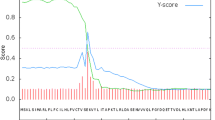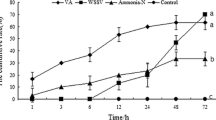Abstract
The complement system plays a crucial role in the innate immune system of animals. It can be activated by distinct yet overlapping classical, alternative and lectin pathways. In the alternative pathway, complement factor B (Bf) serves as the catalytic subunit of complement component 3 (C3) convertase, which plays the central role among three activation pathways. In this study, the Bf gene in sea cucumber (Apostichopus japonicus), termed AjBf, was obtained by rapid amplification of cDNA ends (RACE). The full-length cDNA of AjBf was 3231 bp in length barring the poly (A) tail. It contained an open reading frame (ORF) of 2742 bp encoding 913 amino acids, a 105 bp 5’-UTR (5’-terminal untranslated region) and a 384 bp 3’-UTR. AjBf was a mosaic protein with six CCP (complement control protein) domains, a VWA (von Willebrand factor A) domain, and a serine protease domain. The deduced molecular weight of AjBf protein was 101 kDa. Quantitative real time PCR (qRT-PCR) analysis indicated that the expression level of AjBf in A. japonicus was obviously higher at larval stage than that at embryonic stage. Expression detection in different tissues showed that AjBf expressed higher in coelomocytes than in other four tissues. In addation, AjBf expression in different tissues was induced significantly after LPS or PolyI:C challenge. These results indicated that AjBf plays an important role in immune responses to pathogen infection.
Similar content being viewed by others
References
Al-Sharif, W. Z., Sunyer, J. O., Lambris, J. D., and Smith, L. C., 1998. Sea urchin coelomocytes specifically express a homologue of the complement component C3. Journal of Immunology, 160: 2983–2997.
Franchi, N., and Ballarin, L., 2014. Preliminary characterization of complement in a colonial tunicate: C3, Bf and inhibition of C3 opsonic activity by compstatin. Developmental and Comparative Immunology, 46 (2): 430–438.
Fujita, T., Matsushita, M., and Endo, Y., 2004. The lectin-complement pathway: Its role in innate immunity and evolution. Immunological Reviews, 198: 185–202.
Gross, P. S., Al-Sharif, W. Z., Clow, L. A., and Smith, L. C., 1999. Echinoderm immunity and the evolution of the complement system. Developmental and Comparative Immunology, 23: 429–442.
He, Y., Tang, B., Zhang, S., Liu, Z., Zhao, B., and Chen, L., 2008. Molecular and immunochemical demonstration of a novel member of Bf/C2 homolog in amphioxus Branchiostoma belcheri: Implications for involvement of hepatic cecum in acute phase response. Fish and Shellfish Immunology, 24: 768–778.
Hibino, T., Loza-Coll, M., Messier, C., Majeske, A. J., Cohen, A. H., Terwilliger, D. P., Buckley, K. M., Brockton, V., Nair, S. V., Berney, K., Fugmann, S. D., Anderson, M. K., Pancer, Z., Cameron, R. A., Smith, L. C., and Rast, J. P., 2006. The immune gene repertoire encoded in the purple sea urchin genome. Developmental Biology, 300 (1): 349–365.
Horiuchi, T., Kim, S., Matsumoto, M., Watanabe, I., Fujita, S., and Volanakis, J. E., 1993. Human complement factor B: cDNA cloning, nucleotide sequencing, phenotypic conversion by site-directed mutagenesis and expression. Molecular Immunology, 30: 1587–1592.
Hourcade, D. E., Wagner, L. M., and Oglesby, T. J., 1995. Analysis of the short consensus repeats of human complement factor B by site-directed mutagenesis. Journal of Biological Chemistry, 270: 19716–19722.
Huang, S., Yuan, S., Guo, L., Yu, Y., Li, J., Wu, T., Liu, T., Yang, M., Wu, K., Liu, H., Ge, J., Yu, Y., Huang, H., Dong, M., Yu, C., Chen S., and Xu, A., 2008. Genomic analysis of the immune gene repertoire of amphioxus reveals extraordinary innate complexity and diversity. Genome Research, 18 (7): 1112–1126.
Ishii, Y., Zhu, Z. B., Macon, K. J., and Volanakis, J. E., 1993. Structure of the human C2 gene. Journal of Immunology, 151 (1): 170–174.
Kimura, A., Sakaguchi, E., and Nonaka, M., 2009. Multi-component complement system of Cnidaria: C3, Bf, and MASP genes expressed in the endodermal tissues of a sea anemone, Nematostella vectensis. Immunobiology, 214: 165–178.
Larkin, M. A., Blackshields, G., Brown, N. P., Chenna, R., McGettigan, P. A., McWilliam, H., Valentin, F., Wallace, I. M., Wilm, A., Lopez, R., Thompson, J. D., Gibson, T. J., and Higgins, D. G., 2007. Clustal W and Clustal X version 2.0. Bioinformatics, 23: 2947–2948.
Nonaka, M., 1994. Molecular analysis of the lamprey complement system. Fish and Shellfish Immunology, 4: 437–446.
Nonaka, M., 2014. Evolution of the complement system. Subcellular Biochemistry, 80: 31–43.
Nonaka, M., and Kimura, A., 2006. Genomic view of the evolution of the complement system. Immunogenetics, 58: 701–713.
Nonaka, M., and Yoshizaki, F., 2004. Primitive complement system of invertebrates. Immunological Reviews, 198: 203–215.
Pangburn, M. K., 1983. Activation of complement via the alternative pathway. Federation Proceedings, 42: 139–143.
Pfaffl, M. W., Horgan, G. W., and Dempfle, L., 2002. Relative expression software tool (REST(c)) for group-wise comparison and statistical analysis of relative expression results in real-time PCR. Nucleic Acids Research, 30 (9): e36.
Prado-Alvarez, M., Rotllant, J., Gestal, C., Novoa, B., and Figueras, A., 2009. Characterization of a C3 and a factor B-like in the carpet-shell clam, Ruditapes decussatus. Fish and Shellfish Immunology, 26: 305–315.
Ramírez-Gómez, F., Aponte-Rivera, F., Méndez-Castaner, L., and García-Arrarás J. E., 2010. Changes in holothurian coelomocyte populations following immune stimulation with different molecular patterns. Fish and Shellfish Immunology, 29: 175–185.
Ramírez-Gómez, F., Ortíz-Pineda, P. A., Rivera-Cardona, G., and García-Arrarás, J. E., 2009. LPS-induced genes in intestinal tissue of the sea cucumber Holothuria glaberrima. PLoS. One, 4: 61–78.
Reid, K. B., and Day, A. J., 1989. Structure-function relationships of the complement components. Immunology Today, 10: 177–180.
Santiago-Cardona, P. G., Berríos, C. A., Ramírez, F., and García-Arrarás, J. E., 2003. Lipopolysaccharides induce intestinal serum amyloid A expression in the sea cucumber Holothuria glaberrima. Developmental and Comparative Immunology, 27: 105–110.
Sekine, H., Kenjo, A., Azumi, K., Ohi, G., Takahashi, M., Kasukawa, R., Ichikawa, N., Nakata, M., Mizuochi, T., Matsushita, M., Endo, Y., and Fujita, T., 2001. An ancient lectin-dependent complement system in an ascidian: Novel lectin isolated from the plasma of the solitary ascidian, Halocynthia roretzi. Journal of Immunology, 167: 4504–4510.
Smith, L. C., Shih, C. S., and Dachenhausen, S. G., 1998. Coelomocytes express SpBf, a homologue of factor B, the second component in the sea urchin complement system. Journal of Immunology, 161: 6784–6793.
Tagawa, K., Yoshihara, T., Shibata, T., Kitazaki, K., Endo, Y., Fujita, T., Koshiba, T., and Kawabata, S., 2012. Microbespecific C3b deposition in the horseshoe crab complement system in a C2/factor B-dependent or -independent manner. PLoS One, 7 (5): e36783.
Tamura, K., Dudley, J., Nei, M., and Kumar, S., 2007. MEGA4: Molecular Evolutionary Genetics Analysis (MEGA) software version 4.0. Molecular Biology and Evolution, 24: 1596–1599.
Tuckwell, D. S., Xu, Y., Newham, P., Humphries, M. J., and Volanakis, J. E., 1997. Surface loops adjacent to the cationbinding site of the complement factor B von Willebrand factor type A module determine C3b binding specificity. Biochemistry, 36: 6605–6613.
Wei, W., Wu, H., Xu, H., Xu, T., Zhang, X., Chang, K., and Zhang, Y., 2009. Cloning and molecular characterization of two complement Bf/C2 genes in large yellow croaker (Pseudosciaena crocea). Fish and Shellfish Immunology, 27: 285–295.
Welsh, R. M., 1977. Host cell modification of lymphocytic choriomeningitis virus and Newcastle disease virus altering viral inactivation by human complement. Journal of Immunology, 118: 348–354.
Xu, Y., and Volanakis, J. E., 1997. Contribution of the complement control protein modules of C2 in C4b binding assessed by analysis of C2/factor B chimeras. Journal of Immunology, 158: 5958–5965.
Yang, A. F., Zhou, Z. C., He, C. B., Hu, J. J., Chen, Z., Gao, X. G., Dong, Y., Jiang, B., Liu. W. D., Guan, X. Y., and Wang, X. Y., 2009. Analysis of expressed sequence tags from body wall, intestine and respiratory tree of sea cucumber (Apostichopus japonicus). Aquaculture, 296: 193–199.
Yoshizaki, F. Y., Ikawa, S., Satake, M., Satoh, N., and Nonaka, M., 2005. Structure and the evolutionary implication of the triplicated complement factor B genes of a urochordate ascidian, Ciona intestinalis. Immunogenetics, 56: 930–942.
Zhong, L., Zhang, F., and Chang, Y., 2012. Gene cloning and function analysis of complement B factor-2 of Apostichopus japonicus. Fish and Shellfish Immunology, 33: 504–513.
Zhou, Z. C., Dong, Y., Sun, H. J., Yang, A. F., Chen, Z., Gao, S., Jiang, J. W., Guan, X. Y., Jiang, B., and Wang, B., 2014. Transcriptome sequencing of sea cucumber (Apostichopus japonicus) and the identification of gene-associated markers. Molecular Ecology Resources, 14 (1): 127–138.
Zhou, Z. C., Sun, D. P., Yang, A. F., Dong, Y., Chen, Z., Wang, X. Y., Guan, X. Y., Jiang, B., and Wang, B., 2011. Molecular characterization and expression analysis of a complement component 3 in the sea cucumber (Apostichopus japonicus). Fish and Shellfish Immunology, 31 (4): 540–547.
Zhu, Y., Thangamani, S., Ho, B., and Ding, J. L., 2005. The ancient origin of the complement system. EMBO Journal, 24: 382–394.
Author information
Authors and Affiliations
Corresponding author
Rights and permissions
About this article
Cite this article
Chen, Z., Zhou, Z., Yang, A. et al. Characterization and expression analysis of a complement component gene in sea cucumber (Apostichopus japonicus). J. Ocean Univ. China 14, 1096–1104 (2015). https://doi.org/10.1007/s11802-015-2696-8
Received:
Revised:
Accepted:
Published:
Issue Date:
DOI: https://doi.org/10.1007/s11802-015-2696-8




